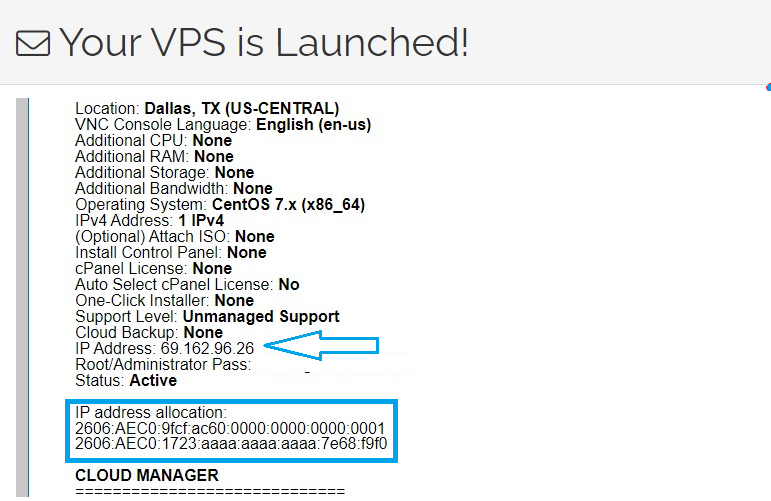This article provides a guide to explain VPS IPv6 address resources assigned with your server.
Explanation of VPS IPv6 Resources
After buying one of our KVM VPS servers, your server details will arrive shortly in the Welcome Email. That email should be similar to the following:

You will notice your server's Primary IP Address identified in the "IP Address:" line of the "Server Details". Any other IPs assigned with the server will be listed under "IP address allocation", just before the "Cloud Manager" details.
In this example the server is assigned 1x IPv4 address (this server's Primary IP Address), 1x IPv6 address and 1x /64 IPv6 subnet.
Under the "IP address allocation:" values (inside the blue rectangle), it appears to list 2x IPv6 addresses and 0x /64 IPv6 subnet and this would be frustrating if you were expecting to receive a /64 subnet with your server order as it would seem that you had been shorted (by about 18,446,744,073,709,551,615 IPs!). Keep reading to learn where to find the "missing" IPs.
How to Identify VPS /64 IPv6 Subnet
Identify the IPv6 address having the following value in the last 4 octets: ":0000:0000:0000:0001" (or "::1" equivalent). The IPv6 address that matches this pattern exactly is actually the designated Gateway IP address and representative of an entire /64 subnet.

So, using the example from before, the IPv6 /64 subnet would be:
2606:AEC0:9fcf:ac60::/64
Keep in mind while configuring the IPv6 networking that the Gateway IP (in this example, 2606:AEC0:9fcf:ac60:0000:0000:0000:0001) should be reserved and not assigned for any specific user or job since it won't be publicly accessible.
Purpose Behind Single VPS IPv6 Address
Knowing what we now know and having identified the VPS IPv6 /64 subnet, you may be questioning the purpose of this single IPv6 address that is also assigned to the server. Our priority is IPv6 enablement across all services, which we provide with this dual stack network.
However, many VPS users either are unfamiliar with IPv6 networks and do not bother to configure the /64 network. So, we provide a single IPv6 for which we have already configured from our cloud network that will automatically be assigned to the primary interface in the same fashion as the IPv4 address is.
This provides native IPv6 access and satisfies the requirements of some users without them having to manage the /64 network configuration. Simply put, this extra IPv6 is simply a mechanism to automate minimal IPv6-enablement in cases such as these.
IPv6 Subnet CIDR Prefixes
2606:aec0:9fcf:ac60:dead:beef:1234:5678 |||| |||| |||| |||| |||| |||| |||| |||| |||| |||| |||| |||| |||| |||| |||| |||| Single end-points and loopback |||| |||| |||| |||| |||| |||| |||| |||128 Point-to-point links (inter-router) |||| |||| |||| |||| |||| |||| |||| ||124 |||| |||| |||| |||| |||| |||| |||| |120 |||| |||| |||| |||| |||| |||| |||| 116 |||| |||| |||| |||| |||| |||| |||112 |||| |||| |||| |||| |||| |||| ||108 |||| |||| |||| |||| |||| |||| |104 |||| |||| |||| |||| |||| |||| 100 |||| |||| |||| |||| |||| |||96 |||| |||| |||| |||| |||| ||92 |||| |||| |||| |||| |||| |88 |||| |||| |||| |||| |||| 84 |||| |||| |||| |||| |||80 |||| |||| |||| |||| ||76 |||| |||| |||| |||| |72 |||| |||| |||| |||| 68 |||| |||| |||| |||64 Single End-user LAN (default prefix size for SLAAC) |||| |||| |||| ||60 Some (very limited) 6rd deployments (/60 = 16 /64) |||| |||| |||| |56 Minimal end sites assignment<ref name=rfc6177/> (e.g. Home network) (/56 = 256 /64) |||| |||| |||| 52 (/52 = 4096 /64) |||| |||| |||48 Typical assignment for larger sites (/48 = 65536 /64) |||| |||| ||44 |||| |||| |40 |||| |||| 36 possible future Local Internet registry extra-small allocations |||| |||32 Local Internet registry minimum allocations |||| ||28 Local Internet registry medium allocations |||| |24 Local Internet registry large allocations |||| 20 Local Internet registry extra large allocations |||16 ||12 Regional Internet Registry allocations from IANA |8 4
 👀 Choose SSD-powered VPS servers for increased speed, power, and security! Now 50% off- starting from only $1.99/mo.
👀 Choose SSD-powered VPS servers for increased speed, power, and security! Now 50% off- starting from only $1.99/mo.


